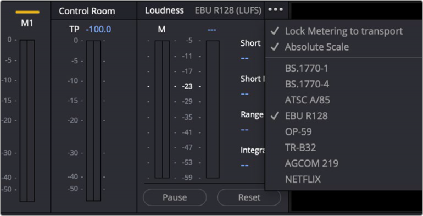
< Previous | Contents | Next >
The Monitoring panel that runs along the top of the Fairlight page shows all of the audio meters corresponding to the tracks in the Timeline, as well as the Master Output meter, Control Room meters, and a video viewer.

The Monitoring panel
At left, a row of audio meters corresponds to the channel strips of the Mixer, one meter for every audio track in the Timeline. Each track meter displays the number of channels that corresponds to that track’s audio format, with mono tracks having a single audio meter, stereo tracks having two, 5.1 tracks having six, and so on. All of these track and bus meters (with the exception of the Loudness meters) display both peak and RMS (root mean square) levels against a dB scale.
To the right of the Track meters are the Bus meters, where all buses appear separated by type, each displaying a meter with the number channels that corresponds to the bus’s audio format. This way you can see the sum of all tracks that have been routed to a particular bus.
The last set of meters, to the right of all others, are the Loudness meters, which consist of two sets of meters and a numerical readout section. The Control Room meter reflects that main output level from the program and the Loudness meter measures the mix’s loudness according to the user’s chosen scale. This lets you keep track of the “integrated loudness” of the overall mix, which is the standard that all contemporary mixing specifications refer to when specifying client deliverables.
The height of the monitoring panel can be adjusted by dragging the bottom of the panel.
Absolute and Relative Measurement Scales
While some users prefer to measure their levels to correspond to a relative scale of “0,” similar to a VU meter where the needle rides above the “0,” others want to see the absolute measure of the
amplitude in LUFS and true peak. By default, the Loudness meter is set to relative scale, but you now have the option to choose between relative scale and absolute scale in the Loudness meter.
Relative scale in the Loudness menu is relative to the selected scale, so a loudness unit of 0 corresponds to the target of the chosen measure type. For instance, if EBU R128 is selected, whose target measure is -23dB LUFS, the “0” LU (Loudness Unit) is equal to -23dB. If ATSC A/85 is chosen, whose target is -24dB, then that becomes the corresponding equivalent of the relative LU of 0.
When using the absolute scale, the Loudness meter displays the increments to reflect the chosen measure type. In absolute scale the EBU R128 meter will display -23 instead of the relative scale’s 0.
